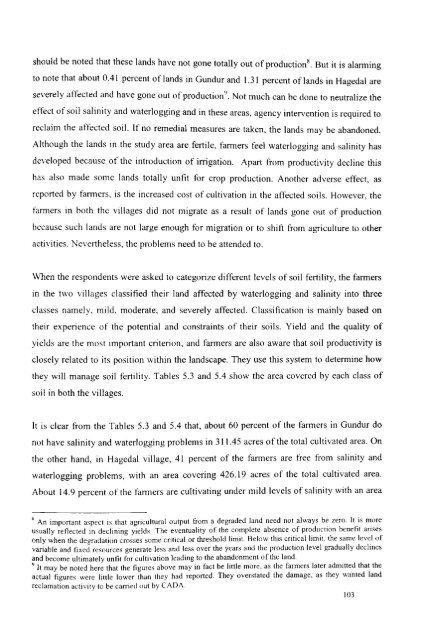Water Users Association and Irrigation Management - Institute for ...
Water Users Association and Irrigation Management - Institute for ...
Water Users Association and Irrigation Management - Institute for ...
You also want an ePaper? Increase the reach of your titles
YUMPU automatically turns print PDFs into web optimized ePapers that Google loves.
should be noted that these l<strong>and</strong>s have not gone totally out of production 8 But it is alanning<br />
to note that about 0.41 percent ofl<strong>and</strong>s in Gundur <strong>and</strong> 1.31 percent ofl<strong>and</strong>s in Hagedal are<br />
severely affected <strong>and</strong> have gone out of production 9 . Not much can be done to neutralize the<br />
ef1'ect of soil salinity <strong>and</strong> waterlogging <strong>and</strong> in these areas, agency intervention is required to<br />
reclaim the affected soil. If no remedial measures are taken, the l<strong>and</strong>s may be ab<strong>and</strong>oned.<br />
Although the l<strong>and</strong>s in the study area are fertile, fanners feel waterlogging <strong>and</strong> salinity has<br />
developed because of the introduction of irrigation. Apart from productivity decline this<br />
has also made some l<strong>and</strong>s totally unfit <strong>for</strong> crop production. Another adverse effect, as<br />
reported by fanners, is the increased cost of cultivation in the affected soils. However, the<br />
fanners in both the villages did not mit-,'fate as a result of l<strong>and</strong>s gone out of production<br />
because such l<strong>and</strong>s are not large enough <strong>for</strong> migration or to shift from agriculture to other<br />
activities. Nevertheless, the problems need to be attended to.<br />
When the respondents were asked to categorize different levels of soil fertility, the fanners<br />
in the two villages classified their l<strong>and</strong> affected by waterlogging <strong>and</strong> salinity into three<br />
classes namely, mild, moderate, <strong>and</strong> severely affected. Classification is mainly based on<br />
their experience of the potential <strong>and</strong> constraints of their soils. Yield <strong>and</strong> the quality of<br />
yields are the most important criterion, <strong>and</strong> fanners are also aware that soil productivity is<br />
closely related to its position within the l<strong>and</strong>scape. They use this system to detennine how<br />
they will manage soil fertility. Tables 5.3 <strong>and</strong> 5.4 show the area covered by each class of<br />
soil in both the villages.<br />
It is clear from the Tables 5.3 <strong>and</strong> 5.4 that, about 60 percent of the fanners in Gundur do<br />
not have salinity <strong>and</strong> waterlogging problems in 311.45 acres of the total cultivated area. On<br />
the other h<strong>and</strong>, in Hagedal village, 41 percent of the fanners are free from salinity <strong>and</strong><br />
waterlogging problems, with an area covering 426.19 acres of the total cultivated area.<br />
About 14.9 percent of the fanners are cultivating under mild levels of salinity with an area<br />
, An important aspect is that agricultural output from a degraded l<strong>and</strong> need not always be zero. It is more<br />
usually reflected In declining yields. The eventuality of the complete absence of production benefit arises<br />
only when the degradation crosses some critical or threshold limit. Below this critical limit. the same level of<br />
variable <strong>and</strong> fixed resources generate less <strong>and</strong> less over the years <strong>and</strong> the production level gradually declines<br />
<strong>and</strong> become ultimately untit <strong>for</strong> cultivation leading to the ab<strong>and</strong>onment of the l<strong>and</strong>.<br />
" It may be noted here that the figures above may in fact be little more, as the farmers later admitted that the<br />
actual figures were little lower than they had reported. They overstated the damage, as they wanted l<strong>and</strong><br />
reclamation activity to be carried out by CADi\.<br />
103
















